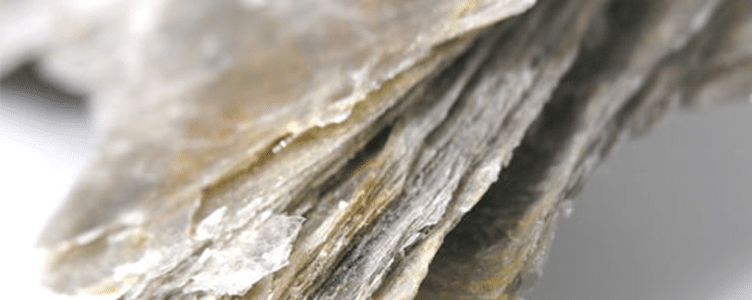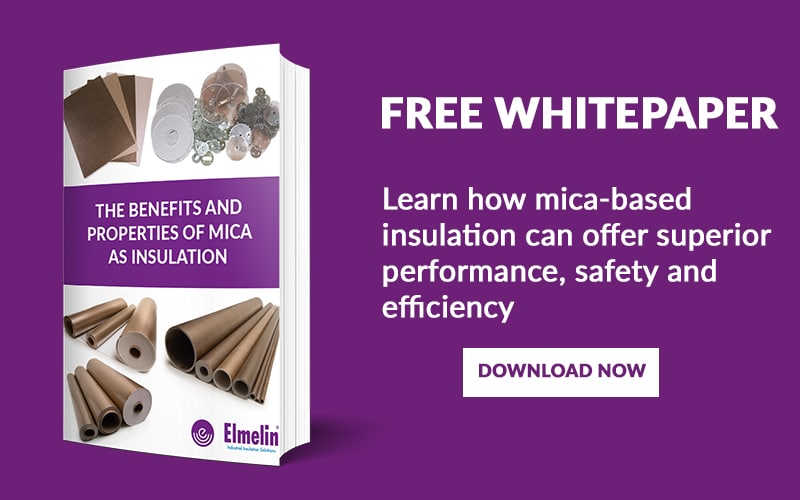
Mica insulation properties vs other common insulation materials
At Elmelin, we have been working with mica as our chosen insulation solution for over 100 years. For us, the benefits of using mica as an insulator are very clear. But obviously, it’s not the only material out there with thermal and electrical insulative properties that is widely used for industrial insulation applications.
With that in mind, we’re going to compare mica-based insulation with 3 other common insulation materials in order to give you a clear view of its performance against the alternatives.
Insulation material comparison table
Before we get into the detail on each individual material and its effectiveness as an insulator, here’s an overview comparison of each material and its properties for reference.
| Material | Dielectric strength (volts per mil – Kv/mm) | Permittivity or dielectric constant | Water absorption | Tensile strength Kg/cm2 (ibs/in2) |
| Muscovite mica | 2000 – 78.74 | 6-71 | Very low (not usually detectable on test) | 1757.67 Kg/cm2 (25000 lbs/in2) |
| Phlogopite mica | 1500 – 59.05 | 5-61 | Very low (not usually detectable on test) | 1757.67 Kg/cm2 (25000 lbs/in2) |
| Nomex 410 (polyimide) | 900 – 118.11 | 2.5/3.02 | >1% | 1195.21 Kg/cm2 (17000 lbs/in2) |
| Kapton (polyimide) | 3000 – 118.11 | 4 | 4% | 1406.13 Kg/cm2 (20000 lbs/in2) |
Mica Insulation Properties
First of all, let’s have a reminder of some of the properties of mica that make it a great electrical and thermal insulator.
Mica is dielectric, which means it’s a very poor conductor of electricity. Pure muscovite mica has a dielectric strength of 2000 volts per millimetre – meaning it’s very good at withstanding high voltages. Working with high voltages often means high temperatures, and the risk of fire. Again, mica-based composite insulation solutions can withstand up to 1600 Degrees C, and mica is non-combustible.
In addition to its dielectric and thermal properties, mica forms in very thin sheets, so it is lightweight, flexible, durable and easy to cut, shape and stamp.
Mica insulation vs Nomex
Nomex is a meta-aramid material – a strong and heat-resistant synthetic fibre – commonly used in electrical laminates such as circuit boards as well as in fireproof honeycomb structures. It is also used in the suits of race car drivers, military pilots and firefighting equipment.
Advantages of Nomex
Nomex is flame-retardant, extremely resistant to heat and dielectric. Its dielectric strength is 900 volts per millimeter. As a synthetic fibre, it is also very flexible and durable, hence its use in clothing. Aramid materials are high strength and low weight, with good resistance to chemicals.
Disadvantages of Nomex
Much like kraft paper, Nomex is also absorbent of moisture, so has to be combined with other materials such as resins to ensure efficiency. Aramid materials are also difficult to cut and grind without specialist materials. Due to this, Nomex insulation solutions can be more expensive when compared to other solutions.
Mica insulation vs Kapton
Kapton is a polyimide film. It is commonly used in flexible printed circuits, as well as space blankets, spacecraft and satellites. Usually in tape form, Kapton is used as an insulation and protection layer on electrostatic sensitive and fragile components. It has a large range of temperature stability and is incredibly strong as a dielectric.
Advantages of Kapton
As mentioned above, Kapton has a very large range of temperature stability, ranging from -269 to 400 Degrees C. It also has a dielectric strength of 3000 volts per mil. It is flame-retardant, transparent to microwaves and unaffected by radiation. As a film, it is incredibly lightweight and flexible.
Disadvantages
Polyimide insulators are expensive. Kapton also has low impact strength and is attacked and broken down by concentrated acids. Despite its extensive temperature stability range, it is not as thermally resistant to extremely high temperatures as other insulation solutions.
Choosing mica insulation
Compared to the other materials reviewed in this post, mica has relatively higher dielectric strength and permittivity, is affected by very little to no moisture absorption, is highly durable and more cost-effective. With our improved CNC milling capabilities, we can flexibly, quickly and cost-effectively produce specialised mica insulation in a range of shapes and sizes at scale.
If you like to talk to us about how mica could help address your insulation challenges, get in touch now.

